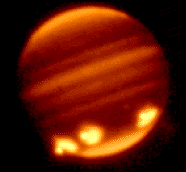 NEXT QUESTION:
NEXT QUESTION:- What is the likelihood of Comet Ison ( estimate the comet to be around 3 miles in diameter) being broken up by the Sun's gravitational forces, into several pieces as it slingshots around the Sun ?
 Astronomers estimated that the visible fragments of SL9 ranged in size from a few hundred metres to two kilometres across.
Astronomers estimated that the visible fragments of SL9 ranged in size from a few hundred metres to two kilometres across. 21 distinct impacts were observed, with the largest coming on July 18 at 07:33 UTC when fragment G struck Jupiter.
This impact created a giant dark spot over 12,000 km across, and was estimated to have released an energy equivalent to 6,000,000 megatons of TNT (600 times the world's nuclear arsenal).[17]
Now since Comet Ison is estimated to be on slightly smaller than Comet Shoemaker–Levy 9 was, WHY WOULDN'T THE DAMAGE (if it breaks up) BE ANY DIFFERENT ?
And if Comet Ison breaks up, can we expect its path to change, given the extra venting gases created by more surface areas to be heated up ?
And would the breaking up of Comet Ison speed up or slow down the shattered pieces velocity on its continued path out away from the Sun?
Or would it totally change the exit point in its slingshot around the Sun to widen the orbit out ?
 How would a crushed Comet Ison compare to the Tunguska event or the space rock that carved Meteor Crater in Arizona ?
How would a crushed Comet Ison compare to the Tunguska event or the space rock that carved Meteor Crater in Arizona ? The Tunguska event was an enormously powerful explosion that occurred near the Podkamennaya Tunguska River in what is now Krasnoyarsk Krai, Russia, at about 07:14 KRAT (00:14 UT) on June 30 [O.S. June 17], 1908.[1][2][3]
The explosion, having the epicentre (60.886°N, 101.894°E), is believed to have been caused by the air burst of a small asteroid or comet at an altitude of 5–10 kilometres (3–6 mi) above Earth's surface.
Different studies have yielded widely varying estimates of the object's size, on the order of 60 m (200 ft) to 190 m (620 ft).[4]
It is the largest impact event on or near Earth in recorded history.
(It is classified as an impact even though the asteroid or comet is believed to have burst in the air rather than hitting the surface.)[5]
 The space rock that carved Meteor Crater in Arizona -- 570 feet deep and 4,100 feet (1.25 kilometers) across -- was blown into existence 50,000 years ago by an asteroid roughly 130 feet (40 meters) wide.
The space rock that carved Meteor Crater in Arizona -- 570 feet deep and 4,100 feet (1.25 kilometers) across -- was blown into existence 50,000 years ago by an asteroid roughly 130 feet (40 meters) wide.So, IF Comet Ison breaks up like Comet Shoemaker–Levy 9 did,
WHY shouldn't we worry about the possibilities of the damage the rubble from Comet Ison could do to our World,
if not on this pass, then on the next return trip into our orbit (who know how many years from now) ?
I found these videos that have very good information from the Deep Impact Discovery Mission to Comet Tempel 1 and I thought they might be worth our time.

1/6 Comets - Not What We Expected

2/6 Comets - Not What We Expected

3/6 Comets - Not What We Expected

4/6 Comets - Not What We Expected

5/6 Comets - Not What We Expected

6/6 Comets - Not What We Expected